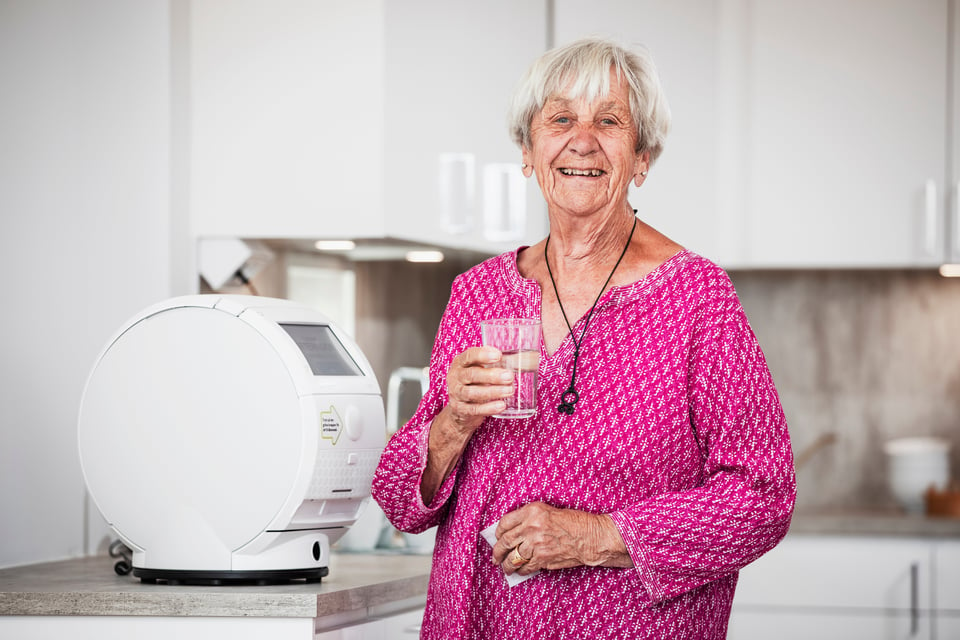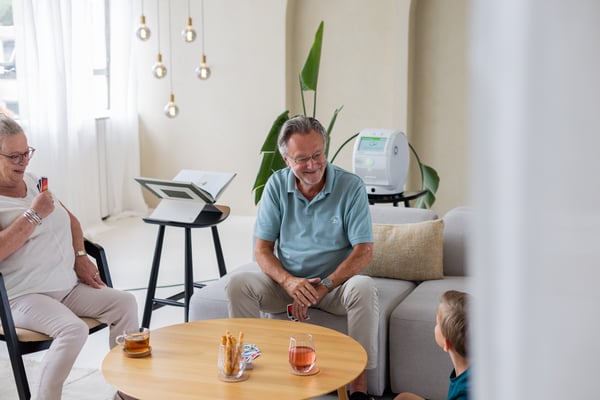
Automatic medication dispensing for enhanced safety and adherence
The harm caused by medication is common and causes morbidity and mortality globally. The good news is that many of these incidents are preventable [1, 2]. A common reason for medication-related harm is non-adherence to medication therapy. It has been estimated that in the UK alone adverse events due to medication results cost nearly £500 from preventable hospital admissions. [3]
Evondos medicine dispensing service is a solution that can address some of the challenges of medication management for older people. This service provides automated and personalized management of medicines to patients in their homes, using an automated medicine dispensing robot that reminds them when to take their doses. The service also allows healthcare professionals to monitor adherence, as they get an alarm in case the client fails to take the medication on time.
The benefits of this service for older people are many. Firstly, it can reduce the risk of harm from non-adherence, which is a common and serious problem for this population group. Older people often have multiple chronic conditions that require complex and frequent medication regimens [4, 5]. Additionally, older people may have impaired cognitive and physical abilities that affect their ability to manage their medicines safely and effectively [4]. By using Evondos service, people can receive the right medicines at the right time, in the right dose and form, without having to worry about sorting, storing or remembering them. This will improve their safety, health outcomes and quality of life.
Secondly, studies have shown that Evondos service enhances adherence to medicines, which is another major issue for patients with multiple medications. Non-adherence to medicines for chronic disease is prevalent among older people and has negative consequences for their health and healthcare costs [6-9]. Non-adherence can be intentional or unintentional and can be influenced by various factors such as lack of knowledge, motivation, support, affordability, or convenience [9]. Evondos service can address some of these factors by providing clear and timely reminders, feedback, and encouragement to the patients, as well as simplifying their medication routines and reducing the burden of handling multiple medicines. Moreover, the service can facilitate communication and collaboration between the patients and their healthcare providers, who can monitor their adherence and intervene if necessary.
In conclusion, Evondos medicine dispensing service is a valuable innovation that can help older people manage their medicines more safely and effectively. The service can potentially prevent harm from medicines, improve adherence to medicines, and ultimately enhance the health and well-being of older people.
The benefits of the Evondos service have been demonstrated in all Nordic countries (often by municipalities and care organizations themselves. Some have reported a double digit decrease in home care visits, improving their organizational efficiency, with a high level of adherence. [10] Adherence of 99% was demonstrated in a paper by Rantanen et al [11]
Sources:
- Angamo MT, Chalmers L, Curtain CM, Bereznicki LRE. Adversedrug-reaction-related hospitalisations in developed and developing countries: a review of prevalence and contributing factors. Drug Saf 2016; 39: 847–57.
- Parekh et. Al. ORIGINAL ARTICLE Incidence and cost of medication harm in older adults following hospital discharge: a multicentre prospective study in the UK. Br J Clin Pharmacol (2018) 84 1789–1797
- Pirmohamde et al. Adverse drug reactions as cause of admission to hospital: prospective analysis of 18 820 patients BMJ VOLUME 329 3 JULY 2004 https://www.bmj.com/content/329/7456/15.abstract
- Guthrie B, Makubate B, Hernandez-Santiago V, Dreishculte T. The rising tide of polypharmacy and drug-drug interactions: population database analysis 1995–2010. BMC Med 2015; 13: 1–10.
- Mangoni A, Jackson S. Age-related changes in pharmacokinetics and pharmacodynamics: basic principles and practical applications. Br J Clin Pharmacol 2003; 57: 6–14
- Barber N, Parsons J, Clifford S, Darracott R, Horne R. Patients’ problems with new medication for chronic conditions. Qual Saf Health Care 2004; 13: 172–5.
- Chowdhury R, Khan H, Heydon E, Shroufi A, Fahimi S, Moore C,et al. Adherence to cardiovascular therapy: a meta-analysis of prevalence and clinical consequences. Eur Heart J 2013; 34: 2940–8.
- Simpson SH, Eurich DT, Majumdar SR, Padwal RS, Tsuyuki RT, Varney J, et al. A meta-analysis of the association between adherence to drug therapy and mortality. BMJ 2006; 333: 15.
- Cutler RL, Fernandez-Llimos F, Frommer M, Benrimoj C, Garcia-Cardenas V. Economic impact of medication non-adherence by disease groups: a systematic review. BMJ Open 2018; 8: e016982.
- Salunen.Evondos helps to achieve operational benefits in homecare. White Paper, Evondos
- Rantanen et sl. An In-home Advanced Robotic System to Manage Elderly Home-care Patients' Medications: A Pilot Safety and Usability Study Clin Ther. 2017 May;39(5):1054-1061





